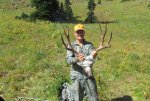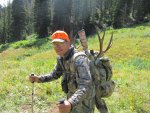Hey guys! My son and I have the points to hopefully draw a decent deer tag this year and we are non residents. We are looking at region H for a backcountry type of hunt or unit 78 in southern WY. I understand region H is popular since it’s a general resident tag have heard unit 78 is getting better since the die off years back. I’ve reached out to the Biologist in 78 and region H and both have given me good info. What’s your alls opinion? If you had points to draw either of these areas which would you choose? We are going to be too picky..looking for mature 4 points. PM me if you want or chime in! Can’t stop thinking about next hunting season! Good luck to everyone in the draws this spring!
WY Region H or unit 78
- Thread starter TN VOL
- Start date
Hilltop
Veteran member
78 was seriously impacted by a fire in 2020. From what we saw the last 2 years, we really feel the migration route was changed for a large number of the deer that used to pass through there during season. You might consider looking across the hwy.Hey guys! My son and I have the points to hopefully draw a decent deer tag this year and we are non residents. We are looking at region H for a backcountry type of hunt or unit 78 in southern WY. I understand region H is popular since it’s a general resident tag have heard unit 78 is getting better since the die off years back. I’ve reached out to the Biologist in 78 and region H and both have given me good info. What’s your alls opinion? If you had points to draw either of these areas which would you choose? We are going to be too picky..looking for mature 4 points. PM me if you want or chime in! Can’t stop thinking about next hunting season! Good luck to everyone in the draws this spring!
RICMIC
Veteran member
I have hunted H five times since 2009, the first two hunts were guided in a wilderness area, and the last 3 I backpacked into some very rugged country. During that time, I have experienced a reduction in mature bucks, an increase in backcountry hunters, and a big inflation in NR points required to draw. (0 to 5). The NR area tags are OTC for residents, so if you have the points I would suggest that part of the equation should be the hunting pressure for the particular unit. On my last hunt we saw lots of deer, and my partner shot a mid-sized 4x4, but I passed on the smaller bucks and ate my tag because of it. Two pairs of hunters moved thru the area and we never saw another deer after that.
Thanks for the reply! How far were you packed into that rugged country you were talking about??I have hunted H five times since 2009, the first two hunts were guided in a wilderness area, and the last 3 I backpacked into some very rugged country. During that time, I have experienced a reduction in mature bucks, an increase in backcountry hunters, and a big inflation in NR points required to draw. (0 to 5). The NR area tags are OTC for residents, so if you have the points I would suggest that part of the equation should be the hunting pressure for the particular unit. On my last hunt we saw lots of deer, and my partner shot a mid-sized 4x4, but I passed on the smaller bucks and ate my tag because of it. Two pairs of hunters moved thru the area and we never saw another deer after that.
Hilltop
Veteran member
Thanks Hilltop..I meant to ask about that..I wonder how the winter has been out in region H thus far??Another thing to consider for the 78 tag, and that entire valley, is this winter has been pretty rough so far in that herd. Good chance there will be at least moderate winter kill.
mnhoundman
Veteran member
Hilltop
Veteran member
I don't have friends in the area that herd winters so don't have recent reports. They tend to do ok because they travel to a pretty safe area for the winter but this year may be different?Thanks Hilltop..I meant to ask about that..I wonder how the winter has been out in region H thus far??
RICMIC
Veteran member
The distance wasn't too far, but we had a vertical gain of over 2,500 ft. that included climbing a cliff. It took us about 6 1/2 hours to get to our campsite, and we were completely bushed by the time we got there. My best buck came after I spiked out from camp an additional 1,300 ft. higher, that was only 1/3rd mile. The spot I shot that buck was completely cliffed out where I don't think even a bighorn could cross.Thanks for the reply! How far were you packed into that rugged country you were talking about??


mntnguide
Very Active Member
Not good. Western WY will experience a bad winter kill this year. Snow is very deep in the low winter range country. Animals are already dying. If the next couple months are a late winter with more snow/cold, this could be one of the bigger die off's in a long time. pretty unfortunate, because we were just starting to get to a good spot with the winter kill from 4-5 years ago.Thanks Hilltop..I meant to ask about that..I wonder how the winter has been out in region H thus far??
manitou1
Member
Yup. And more snow coming. Not looking good.Not good. Western WY will experience a bad winter kill this year. Snow is very deep in the low winter range country. Animals are already dying. If the next couple months are a late winter with more snow/cold, this could be one of the bigger die off's in a long time. pretty unfortunate, because we were just starting to get to a good spot with the winter kill from 4-5 years ago.
manitou1
Member
Sheridan is expecting another 12" today and Buffalo, another 5-6"... with 60 mph winds!
I am wearing out the snow shovel this season.
I am wearing out the snow shovel this season.
Slugz
Veteran member
Hilltop
Veteran member
Not your average fire that produces more food. Many of the typical deer areas still look like the moon. That fire burned HOT. Most of the bucks a guy shoots in 78 spend the spring and summer eating 50-100 miles south in Colorado. There is a reason it takes quite a few less points to draw than the other side of the valley... It just isn't the hunt it once was.Fire = lots of feed
Snow = winter kill + needed moisture
Genetics = still there
78
Slugz
Veteran member
Chiming in late here, but I have to agree. Not all fires are equal, when something is moonscaped, it takes years. However, fast moving crowning fires or fires with minimal areas of ground burn can come back quick. The ones that really suck to figure out are when they are moonscaped in one drainage and then crowned in the next. That said, H is probably what I would do.Not your average fire that produces more food. Many of the typical deer areas still look like the moon. That fire burned HOT. Most of the bucks a guy shoots in 78 spend the spring and summer eating 50-100 miles south in Colorado. There is a reason it takes quite a few less points to draw than the other side of the valley... It just isn't the hunt it once was.
Slugz
Veteran member
Hilltop / Scott,
Either of you have boots on the ground in there this fall ? Just wondering as I'm getting conflicting info.
Thanks
Either of you have boots on the ground in there this fall ? Just wondering as I'm getting conflicting info.
Thanks
Hilltop
Veteran member
DoubleDropMuley
Active Member
- Apr 18, 2020
- 250
- 288
Here's some of WG&F's report from March 6 for the area H is in and it's still snowing.
JACKSON/PINEDALE REGIONS
These regions experienced an early onset of winter beginning in late October with about average snowfall to date in the mountains, but above-average snow levels on lower-elevation winter ranges and consistently colder than normal temperatures. Wildlife managers can access near real-time mortality information through GPS-collared animals, which are currently showing greater than 50 percent mortality of collared mule deer fawns in the Wyoming Range herd, and currently average mortality of collared adults in the Sublette and Wyoming Range deer herds. Juvenile mortality typically averages about 25 percent in these herds. When inspected nearly all of the mortalities were found to have gelatinous bone marrow signifying malnutrition. By all accounts, managers are expecting to see above-average mortality for both mule deer and pronghorn. However, an accurate assessment of loss won’t be known until later this spring as many animals, particularly adults, won’t succumb to winter until April or May.
JACKSON/PINEDALE REGIONS
These regions experienced an early onset of winter beginning in late October with about average snowfall to date in the mountains, but above-average snow levels on lower-elevation winter ranges and consistently colder than normal temperatures. Wildlife managers can access near real-time mortality information through GPS-collared animals, which are currently showing greater than 50 percent mortality of collared mule deer fawns in the Wyoming Range herd, and currently average mortality of collared adults in the Sublette and Wyoming Range deer herds. Juvenile mortality typically averages about 25 percent in these herds. When inspected nearly all of the mortalities were found to have gelatinous bone marrow signifying malnutrition. By all accounts, managers are expecting to see above-average mortality for both mule deer and pronghorn. However, an accurate assessment of loss won’t be known until later this spring as many animals, particularly adults, won’t succumb to winter until April or May.


